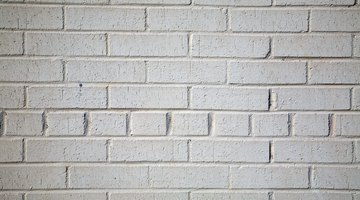How to Whitewash a Cinder Block Wall
Whitewashing may not be quite as much fun as Tom Sawyer claimed, but it is an efficient and simple way to take a cinder block wall from utilitarian to utterly fabulous. Exact formulas vary, but most whitewash is a mixture of water, slaked lime, salt and chalk that hardens to a crisp, clean white finish.

Whitewashing may not be quite as much fun as Tom Sawyer claimed, but it is an efficient and simple way to take a cinder block wall from utilitarian to utterly fabulous. Exact formulas vary, but most whitewash is a mixture of water, slaked lime, salt and chalk that hardens to a crisp, clean white finish. Cement blocks are porous, so you may need several coats of whitewash to get the effect for which you are looking.
-
Spread drop cloths to protect the floor and any nearby furnishings. Whitewash has a tendency to splatter more than other types of finishes, so make sure the area is well protected.
-
Dilute a degreasing cleanser such as dish soap in a bucket of hot water. One or two squirts of soap in 1 quart of water cleans a mildly dusty wall, but if you are dealing with oil or grease, use a stronger cleanser, such as trisodium phosphate (TSP) diluted according to the instructions on the label.
-
Soak a sponge in the degreasing solution and wring it out until it’s just damp. Wear gloves if you are using TSP. Clean the cinder block wall from top to bottom, soaking and wringing out the sponge as needed. Let the wall dry completely.
-
Put on protective goggles and gloves, and mix the whitewash mix and water according to the directions on the label. Use a paint stirrer to combine them thoroughly.
-
Apply the whitewash to the wall, starting at the top and working your way down. Whitewash tends to drip and run more than thicker paint, so don’t press the brush or roller hard against the wall.
-
Cover the wall entirely with whitewash. Let it dry completely before deciding whether to add another coat.
Things You Will Need
- Drop cloths
- Degreasing cleanser
- Sponge
- Gloves
- Goggles
- Whitewash mix
- Water
- Bucket
- Paint stirrers
- Paintbrushes or rollers
Tip
Tint whitewash with natural pigments for a soft hint of color. Whitewash tends to be thin, so don’t worry if it is not as thick as you expect it to be.
Warning
Never handle whitewash containing lime without protective gear.
References
Writer Bio
Emmy-award nominated screenwriter Brynne Chandler is a single mother of three who divides her time between professional research and varied cooking, fitness and home & gardening enterprises. A running enthusiast who regularly participates in San Francisco's Bay to Breakers run, Chandler works as an independent caterer, preparing healthy, nutritious meals for Phoenix area residents.
Photo Credits
- Jupiterimages/Photos.com/Getty Images
- Jupiterimages/Photos.com/Getty Images
More Articles



